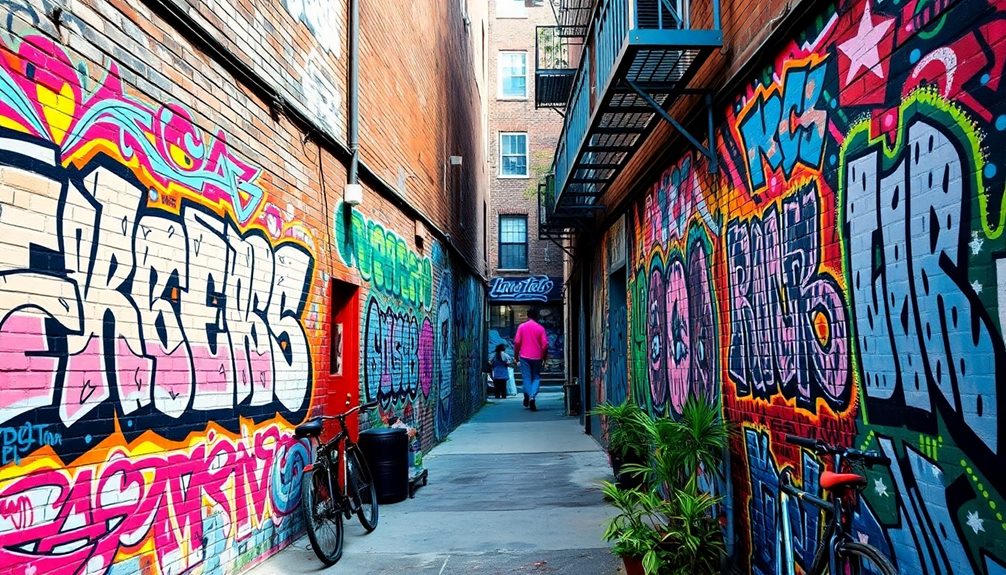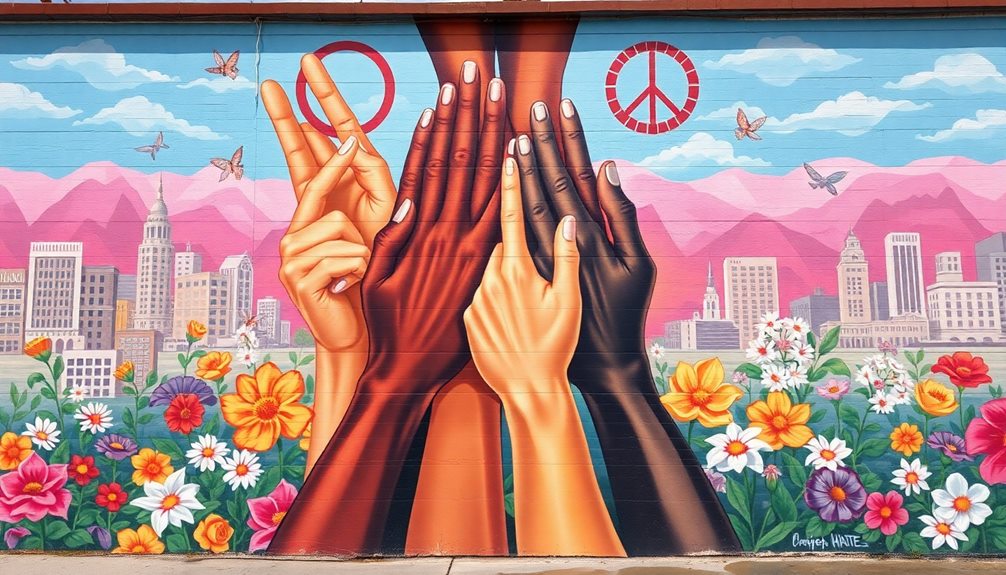Street art's vibrant visuals and social messages create a fascinating dialogue in urban spaces. Originating in the 1920s, it transformed from graffiti to a respected art form. Artists like Banksy and Keith Haring use bold imagery to comment on social issues, making it accessible and engaging. You'll notice that street art revitalizes neighborhoods, fostering community pride and dialogue. While often confused with graffiti, street art emphasizes intent and involvement in public discourse. Its growing recognition in contemporary art circles highlights its cultural significance. Explore further, and you'll uncover deeper insights into this dynamic and evolving artistic movement.
Key Takeaways
- Street art originated in the 1920s and 1930s, evolving from graffiti into a platform for social and political commentary.
- Key techniques include aerosol tagging, stenciling, and digital mediums, often using humor to convey messages.
- Notable artists like Banksy and Keith Haring use their work to critique consumerism and advocate for social change.
- Street art revitalizes urban spaces, fostering community pride and dialogue about cultural identity.
- Legal challenges persist, but increasing recognition and legitimacy in art circles continue to shape the future of street art.
Historical Development of Street Art

The evolution of street art reflects a dynamic interplay between social expression and urban landscapes. Modern street art originated in New York City during the 1920s and 1930s, emerging as a response to gang wars and economic struggles.
By the 1970s, graffiti artists began using their art to voice social commentary, transforming streets into vibrant canvases for marginalized communities. The historical development of this movement saw the shift from simple tagging to elaborate subway murals, with artists working to create unique styles that set them apart.
In the 1960s and 1970s, NYC and Philadelphia became hotbeds for artistic expression, where abandoned properties turned into stages for creativity. Influential photographer Martha Cooper played an essential role in documenting this scene, helping to legitimize street art through her work, including the seminal book "Subway Art."
The 1980s marked a significant change, as artists like Keith Haring and Jean-Michel Basquiat bridged the gap between street art and the fine art world. Their success helped to elevate street art to public art, showcasing its power to engage with social issues and transform urban environments.
Themes and Techniques

Exploring themes and techniques in street art reveals a rich tapestry of creativity that challenges societal norms. Street art isn't just about making a statement; it's about engaging with the world around you. Here are three key aspects to contemplate:
- Social and Political Activism: Many artists tackle issues like inequality and consumerism, provoking discussions that resonate with the public.
- Diverse Techniques: From aerosol tagging and stenciling to innovative methods like yarnbombing and LED installations, street artists use various techniques to create visually striking works.
- Humor and Satire: Many contemporary artists cleverly employ humor to critique societal norms, making their messages more accessible and engaging.
Artists like Banksy and Blu exemplify how themes and techniques merge in street art. They use large-scale murals to blend visual art with poignant commentary, reaching broader audiences.
Graffiti vs. Street Art

At first glance, graffiti and street art might seem interchangeable, but they represent distinct forms of expression within urban landscapes. Graffiti primarily focuses on text and tagging, often linked to hip-hop culture and rebellion. In contrast, street art emphasizes imagery and graphic design, conveying broader political or social messages.
The key difference lies in intent. Graffiti is typically illegal and often viewed as vandalism, while street art can be legally sanctioned and commissioned, enhancing public spaces.
Graffiti emerged in the late 1960s as a means of self-expression among marginalized communities, whereas street art evolved to incorporate various techniques like stenciling and murals that engage with public discourse.
Contemporary street artists, such as Banksy and Shepard Fairey, shifted from graffiti roots to mainstream recognition, using their platforms to address societal issues and critique consumerism. This change reflects the changing perception of graffiti as mere vandalism to a growing acceptance of street art as a legitimate form of artistic expression.
Ultimately, both forms of urban art contribute to the vibrant tapestry of city life, each telling unique stories and challenging viewers to reflect on their surroundings.
Notable Street Artists

When you explore notable street artists, you'll encounter pioneers like Banksy and Keith Haring, whose iconic works have left a lasting mark on culture.
Each artist brings a unique perspective, addressing social issues through their art, which can inspire and provoke thought.
Let's look closer at their significant contributions and the impact they've had on the street art movement.
Pioneering Artists Overview
Street art has been shaped by a diverse group of pioneering artists who've pushed boundaries and challenged societal norms. These influential street artists not only create vibrant murals but also engage with pressing social issues through their public works.
Here are three notable figures:
- Banksy – This mysterious artist critiques consumerism and war through subversive stencils, maintaining anonymity while making powerful statements.
- Keith Haring – Emerging in the 1980s, Haring's cartoon-like figures addressed the AIDS crisis, blending art with activism in his public murals.
- Lady Pink – As a pioneering female figure, she uses graffiti to advocate for women's empowerment, conducting mural workshops to inspire others.
These pioneering street artists exemplify how graffiti and street art can serve as platforms for political messaging and social commentary.
From Blu's large-scale murals addressing urban decay to Shepard Fairey's iconic "Hope" poster, each artist adds a unique voice to the tapestry of modern street art. Their work transforms public spaces into canvases for dialogue, helping you to see art as a vehicle for change.
Iconic Works Highlighted
Iconic works from notable street artists frequently capture the essence of their time, blending personal expression with powerful social commentary. Each artist brings their unique perspective to public spaces, tackling significant social issues that resonate with audiences worldwide.
Here's a look at five influential street artists and their iconic creations:
| Artist | Notable Work | Themes |
|---|---|---|
| Keith Haring | "Crack is Wack" | AIDS crisis, addiction |
| Banksy | "Girl with a Balloon" | Societal norms, hope |
| Shepard Fairey | "Hope" poster | Political activism, empowerment |
| Lady Pink | Large-scale murals | Women's empowerment, graffiti culture |
| Blu | "MUTO" | Oppression, urban decay |
These artists, like Keith Haring and Banksy, not only beautify urban landscapes but also provoke thought and spark discussions about pressing social issues. Their works remain relevant, continuing to inspire new generations to engage with street art as a powerful form of expression.
Cultural Impact Assessment
Throughout the years, notable street artists have reshaped cultural landscapes, leaving a lasting impact on society. Their work in public spaces challenges norms and stimulates dialogue around pressing social issues. Here are three key contributions:
- Banksy: This anonymous artist's provocative pieces have transformed public perception of street art into a respected contemporary art form.
- Keith Haring: By addressing the AIDS crisis through his vibrant murals, Haring used his artistry to advocate for social change across the globe.
- Shepard Fairey: His iconic "Obey Giant" campaign and the "Hope" poster for Barack Obama illustrate the powerful intersection of street art and political activism.
These artists' work not only beautifies urban environments but also engages communities in conversations on critical topics.
Lady Pink's murals empower women, while CornBread champions youth engagement in the arts. Each of these creators contributes to the cultural impact of street art, making it a dynamic platform for expression and awareness.
As you explore these artists, consider how their messages resonate in today's society and the role street art plays in shaping cultural narratives.
Impact on Urban Society

In urban environments, the impact of street art is transformative, turning neglected spaces into vibrant open-air galleries that enhance community pride. You can see how street art revitalizes urban landscapes, making them more inviting and engaging for residents and visitors alike.
This art form serves as a powerful platform for social and political expression, raising awareness about pressing issues such as inequality, injustice, and environmental concerns. It reflects the socio-political climate of the neighborhoods where it appears, fostering dialogue among community members.
Moreover, studies, including those by Bloomberg Philanthropies, indicate that street art can contribute to reduced crime rates and improve safety perceptions in urban areas. By beautifying public spaces, street art attracts tourism and stimulates local economies, breathing new life into areas previously deemed uninviting.
This movement also challenges the exclusivity of traditional art forms, democratizing art access and allowing everyone to appreciate and engage with creative expressions on their streets. Ultimately, street art enriches urban societies, cultivating a sense of belonging and pride while encouraging civic participation and community engagement.
Cultural Significance

Street art carries immense cultural significance, acting as a vibrant canvas for social and political commentary. It addresses pressing issues like inequality, injustice, and consumerism, giving a voice to marginalized communities.
Here are three key aspects of its cultural impact:
- Revitalization of Public Spaces: Street art transforms bland urban environments into dynamic galleries, inviting community interaction and engagement.
- Promotion of Community Pride: Locals often take pride in their neighborhoods when adorned with impactful street art, strengthening bonds among residents.
- Support for Grassroots Movements: Many street artists use their work to promote grassroots movements, channeling the collective voice of the community.
Recognition and Legitimacy

The cultural significance of street art has paved the way for its growing recognition and legitimacy within the art world. You might notice that street art is increasingly celebrated in contemporary art circles, with festivals, exhibitions, and galleries showcasing its diverse forms. Artists like Banksy have achieved international fame, with their works commanding high auction prices, proving that street art isn't just a fleeting trend but a valuable art form.
However, this recognition hasn't come without challenges. The relationship between street art and public spaces often leads to legal battles over property rights and permissions. This tension reflects the ongoing struggle artists face in maneuvering city governance, as seen in the 1980s when New York's Clean Car Program aimed to eliminate subway graffiti.
Fortunately, the rise of digital platforms and social media has considerably expanded the visibility of street artists. Now, you can engage in a global dialogue about their work, further contributing to the movement's ongoing recognition.
As street art continues to gain legitimacy, it certainly reshapes our understanding of art in public spaces and its role in contemporary society.
Ongoing Challenges and Future Trends

When you explore the ongoing challenges in street art, you'll notice how legal issues and regulations often complicate artists' efforts to express themselves.
As artistic techniques evolve, so do community engagement strategies that help bridge gaps between artists and the public.
It's essential to reflect on how these factors might shape the future of street art in your city and beyond.
Legal Issues and Regulations
As artists navigate the complex landscape of street art, legal issues and regulations continually challenge their expression and creativity. Here are three key factors you should consider:
- Property Rights: Disputes over ownership often arise, especially in cases like Banksy's "Mobile Lovers," where the line between artistic expression and vandalism blurs.
- Visual Artists Rights Act (VARA): This act provides moral rights to street artists, allowing them to claim ownership and seek protection, but only if their art is legally installed and considered original.
- Urban Development and Regulation: Many cities are now recognizing the cultural value of street art and have implemented legal mural programs that allow for commissioned works, helping to legitimize the art form.
However, these advancements don't eliminate ongoing challenges. The rise of digital platforms complicates copyright issues, while cities struggle to balance community beautification with the preservation of street art amidst ongoing urban development.
As you explore this vibrant artistic scene, keep these legal considerations in mind, as they play a vital role in shaping the future of street art.
Evolving Artistic Techniques
Street art is constantly evolving, reflecting both technological advancements and the shifting cultural landscape. You'll notice that artists are now incorporating digital mediums, like augmented reality (AR) and video projections, which expand the traditional boundaries of public art. These evolving artistic techniques not only capture attention but also invite deeper interaction with the audience.
Many street artists are turning to sustainable materials and innovative methods, such as reverse graffiti, which cleans surfaces to create images. This approach raises awareness about urban pollution, blending art with environmental consciousness.
As legal street art projects and sanctioned murals become more common, there's a growing acceptance of street art within urban planning, promoting community engagement and beautification efforts.
Collaborative murals often involve local communities, allowing you to see how artists adapt their styles to reflect the cultural narratives and histories of their surroundings.
However, ongoing challenges persist, especially in balancing commercialization with grassroots authenticity. As street art gains recognition in mainstream art markets, it's crucial to maintain its subversive roots while encouraging creativity and expression in public spaces.
Community Engagement Strategies
Many communities are discovering the power of street art as a tool for engagement and identity building. By collaborating with local artists, residents can breathe life into their neighborhoods and celebrate their unique cultural identity.
This creative expression not only enhances the visual landscape but also fosters emotional resilience and community pride, as seen in the power of imagination.
Here are three effective community engagement strategies:
- Collaborative Murals: Involving residents in the design and execution of murals fosters ownership and pride in the space.
- Initiatives like Beautify Earth: These programs transform neglected areas, enhancing both aesthetics and community spirit.
- Festivals and Events: Platforms like the MURAL Festival in Montreal encourage interaction between artists and community members, promoting dialogue and cultural exchange.
Despite the benefits, ongoing challenges remain, including maneuvering legal restrictions and obtaining permission from property owners.
Street artists must carefully balance their artistic expression with community and governmental expectations.
Cities like Philadelphia and Atlanta have documented over 200 street art pieces, showcasing how constructive use of graffiti talents can deepen community engagement.
As communities continue to embrace street art, the potential for building identity and fostering connections remains limitless.
Frequently Asked Questions
What Is the Main Idea of Street Art?
Street art's main idea revolves around self-expression and social commentary. You see it transforming urban spaces into vibrant canvases, encouraging conversations about societal issues while challenging conventional art norms and engaging a wider audience.
What Are the Three Types of Street Art?
Did you know over 80% of urban dwellers appreciate street art? You'll find three main types: graffiti, murals, and stencils. Each brings unique vibes and messages to cityscapes, transforming ordinary spaces into extraordinary expressions.
How Do I Get Started in Street Art?
To get started in street art, gather essential materials, practice techniques on smaller surfaces, and experiment with styles. Join local communities for collaboration, gain feedback, and document your work to build your portfolio.
What Are the Key Features of Street Art?
You'll notice vibrant colors splashing across walls, bold messages challenging norms, and intricate designs capturing attention. Street art's key features include public accessibility, social commentary, and a blend of diverse techniques that inspire and provoke thought.
Conclusion
In the vibrant tapestry of urban life, street art breathes color and meaning into grey walls, transforming neglected spaces into powerful canvases of expression. It challenges you to see beyond the ordinary, revealing stories that often go unheard. As street art continues to evolve, its impact on society only grows stronger, reminding you that creativity knows no bounds. Embrace this movement, and let it inspire you to find beauty in the unexpected corners of your own world.









